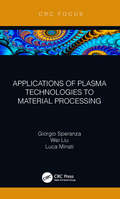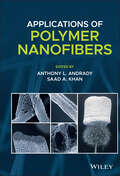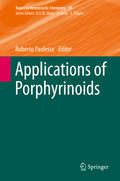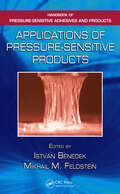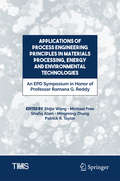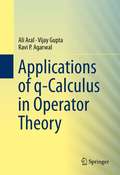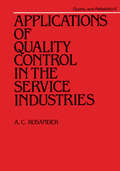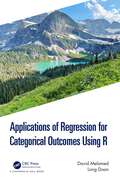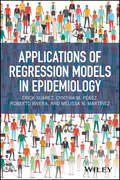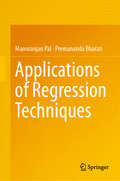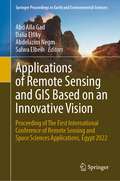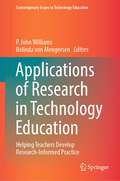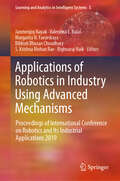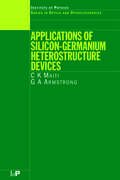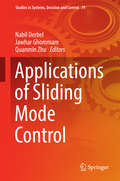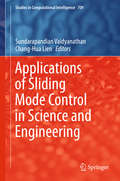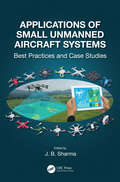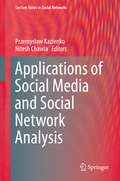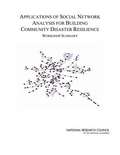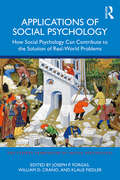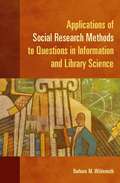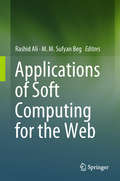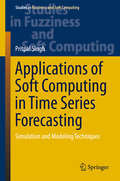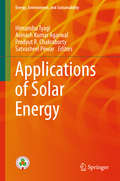- Table View
- List View
Applications of Plasma Technologies to Material Processing
by Giorgio Speranza Wei Liu Luca MinatiThis book provides a survey of the latest research and developments in plasma technology. In an easy and comprehensive manner, it explores what plasma is and the technologies utilized to produce plasma. It then investigates the main applications and their benefits. Different from other books on the topic that focus on specific aspects of plasma technology, the intention is to provide an introduction to all aspects related to plasma technologies. This book will be an ideal resource for graduate students studying plasma technologies, in addition to researchers in physics, engineering, and materials science Features Accessible and easy to understand Provides simple yet exhaustive explanations of the foundations Explores the latest technologies and is filled with practical applications and case studies
Applications of Polymer Nanofibers
by Anthony L. Andrady Saad A. KhanAPPLICATIONS OF POLYMER NANOFIBERS Explore a comprehensive review of the practical experimental and technological details of polymer nanofibers with a leading new resource Applications of Polymer Nanofibers delivers a complete introduction to the basic science of polymer nanofibers as well as a review of their diverse applications. The book assesses their potential for commercialization and presents contributions from leading experts emphasizing their practical and technological details. New and up to date research findings are presented throughout the book in areas including filters, fabric, energy, fuel cells, batteries, sensors, biomedicine, drug delivery, tissue engineering, and wound dressings. The book also presents a fulsome analysis of the technology of electrospinning, the most convenient and scalable technique for nanofiber production. It also provides readers with practical information on relevant surface modification techniques. Applications of Polymer Nanofibers effectively balances theoretical background with practical applications of the technology, including insights into polymer nanofiber materials that will be useful for advanced students and researchers. Students, researchers, and industry professionals will also enjoy the inclusion of: A thorough introduction to electrospinning parameters and resulting nanofiber characteristics, including theoretical and practical considerations An exploration of textile applications of nanofibers, like protective clothing, filter fabrics, wearable devices, functional fabrics, and biomedical textiles A review of nanofiber mats as high-efficiency filters, including filtration developments, filters made with nanofibers, and the future outlook for nanofiber filters A treatment of nanofiber-based chemical sensors, including sensor materials, approaches to nanofiber sensor design, and gravimetric nanofiber sensors Perfect for researchers and graduate students studying polymer science and engineering, chemical engineering, materials science, and nanotechnology. Applications of Polymer Nanofibers will also earn a place in the libraries of industrial researchers concerned with electrospinning, air filtration, fabrics, drug delivery, catalysis, and biomedicine.
Applications of Porphyrinoids (Topics in Heterocyclic Chemistry #34)
by Roberto PaolesseThe series Topics in Heterocyclic Chemistry presents critical reviews on present and future trends in the research of heterocyclic compounds. Overall the scope is to cover topics dealing with all areas within heterocyclic chemistry, both experimental and theoretical, of interest to the general heterocyclic chemistry community. The series consists of topic related volumes edited by renowned editors with contributions of experts in the field. All chapters from Topics in Heterocyclic Chemistry are published Online First with an individual DOI. In references, Topics in Heterocyclic Chemistry is abbreviated as Top Heterocycl Chem and cited as a journal.
Applications of Pressure-Sensitive Products (Handbook of Pressure-Sensitive Adhesives and Products)
by IstvÁn Benedek Mikhail M. FeldsteinPresenting the end-use and application technologies of pressure-sensitive adhesives and products, Volume Three of the Handbook of Pressure-Sensitive Adhesives and Products discusses the build up and classes
Applications of Process Engineering Principles in Materials Processing, Energy and Environmental Technologies: An EPD Symposium in Honor of Professor Ramana G. Reddy (The Minerals, Metals & Materials Series)
by Mingming Zhang Shafiq Alam Shijie Wang Michael L Free Patrick R. TaylorThis collection offers new research findings, innovations, and industrial technological developments in extractive metallurgy, energy and environment, and materials processing. Technical topics included in the book are thermodynamics and kinetics of metallurgical reactions, electrochemical processing of materials, plasma processing of materials, composite materials, ionic liquids, thermal energy storage, energy efficient and environmental cleaner technologies and process modeling. These topics are of interest not only to traditional base ferrous and non-ferrous metal industrial processes but also to new and upcoming technologies, and they play important roles in industrial growth and economy worldwide.
Applications of q-Calculus in Operator Theory
by Ravi P Agarwal Ali Aral Vijay GuptaThe approximation of functions by linear positive operators is an important research topic in general mathematics and it also provides powerful tools to application areas such as computer-aided geometric design, numerical analysis, and solutions of differential equations. q-Calculus is a generalization of many subjects, such as hypergeometric series, complex analysis, and particle physics. This monograph is an introduction to combining approximation theory and q-Calculus with applications, by using well- known operators. The presentation is systematic and the authors include a brief summary of the notations and basic definitions of q-calculus before delving into more advanced material. The many applications of q-calculus in the theory of approximation, especially on various operators, which includes convergence of operators to functions in real and complex domain forms the gist of the book. This book is suitable for researchers and students in mathematics, physics and engineering, and for professionals who would enjoy exploring the host of mathematical techniques and ideas that are collected and discussed in the book.
Applications of Quality Control in the Service Industries (Quality and Reliability)
by A. C. RosanderThis book discusses basic concepts, principles, and quality characteristics in the service industries, an understanding of the techniques and their applications. It helps to close the gap between proven principles and successful applications.
Applications of Quantum Dynamics in Chemistry (Lecture Notes in Chemistry #98)
by Fabien Gatti Benjamin Lasorne Hans-Dieter Meyer André NautsThis book explains the usage and application of Molecular Quantum Dynamics, the methodology where both the electrons and the nuclei in a molecule are treated with quantum mechanical calculations. This volume of Lecture Notes in Chemistry addresses graduate students and postdocs in the field of theoretical chemistry, as well as postgraduate students, researchers and teachers from neighboring fields, such as quantum physics, biochemistry, biophysics, or anyone else who is interested in this rising method in theoretical chemistry, and who wants to gain experience in the opportunities it can offer. It can also be useful for teachers interested in illustrative examples of time-dependent quantum mechanics as animations of realistic wave packets have been designed to assist in visualization. Assuming a basic knowledge about quantum mechanics, the authors link their explanations to recent experimental investigations where Molecular Quantum Dynamics proved successful and necessary for the understanding of the experimental results. Examples including reactive scattering, photochemistry, tunneling, femto- and attosecond chemistry and spectroscopy, cold chemistry or crossed-beam experiments illustrate the power of the method. The book restricts complicated formalism to the necessary and in a self-contained and clearly explained way, offering the reader an introduction to, and instructions for, practical exercises. Continuative explanation and math are optionally supplemented for the interested reader. The reader learns how to apply example simulations with the MCTDH program package (Multi Configuration Time Dependent Hartree calculations). Readers can thus obtain the tools to run their own simulations and apply them to their problems. Selected scripts and program code from the examples are made available as supplementary material. This book bridges the gap between the existing textbooks on fundamental theoretical chemistry and research monographs focusing on sophisticated applications. It is a must-read for everyone who wants to gain a sound understanding of Molecular Quantum Dynamics simulations and to obtain basic experience in running their own simulations.
Applications of Regression for Categorical Outcomes Using R
by David Melamed Long DoanThis book covers the main models within the GLM (i.e., logistic, Poisson, negative binomial, ordinal, and multinomial). For each model, estimations, interpretations, model fit, diagnostics, and how to convey results graphically are provided. There is a focus on graphic displays of results as these are a core strength of using R for statistical analysis. Many in the social sciences are transitioning away from using Stata, SPSS and SAS, to using R, and this book uses statistical models which are relevant to the social sciences. Social Science Applications of Regression for Categorical Outcomes Using R will be useful for graduate students in the social sciences who are looking to expand their statistical knowledge, and for Quantitative social scientists due to it’s ability to act as a practitioners guide. Key Features: Applied- in the sense that we will provide code that others can easily adapt Flexible- R is basically just a fancy calculator. Our programs will enable users to derive quantities that they can use in their work Timely- many in the social sciences are currently transitioning to R or are learning it now. Our book will be a useful resource Versatile- we will write functions into an R package that can be applied to all of the regression models we will cover in the book Aesthetically pleasing- one advantage of R relative to other software packages is that graphs are fully customizable. We will leverage this feature to yield high-end graphical displays of results Affordability- R is free. R packages are free. There is no need to purchase site licenses or updates.
Applications of Regression Models in Epidemiology
by Roberto Rivera Melissa N. Martínez Erick Suárez Cynthia M. PérezA one-stop guide for public health students and practitioners learning the applications of classical regression models in epidemiology This book is written for public health professionals and students interested in applying regression models in the field of epidemiology. The academic material is usually covered in public health courses including (i) Applied Regression Analysis, (ii) Advanced Epidemiology, and (iii) Statistical Computing. The book is composed of 13 chapters, including an introduction chapter that covers basic concepts of statistics and probability. Among the topics covered are linear regression model, polynomial regression model, weighted least squares, methods for selecting the best regression equation, and generalized linear models and their applications to different epidemiological study designs. An example is provided in each chapter that applies the theoretical aspects presented in that chapter. In addition, exercises are included and the final chapter is devoted to the solutions of these academic exercises with answers in all of the major statistical software packages, including STATA, SAS, SPSS, and R. It is assumed that readers of this book have a basic course in biostatistics, epidemiology, and introductory calculus. The book will be of interest to anyone looking to understand the statistical fundamentals to support quantitative research in public health. In addition, this book: • Is based on the authors’ course notes from 20 years teaching regression modeling in public health courses • Provides exercises at the end of each chapter • Contains a solutions chapter with answers in STATA, SAS, SPSS, and R • Provides real-world public health applications of the theoretical aspects contained in the chapters Applications of Regression Models in Epidemiology is a reference for graduate students in public health and public health practitioners. ERICK SUÁREZ is a Professor of the Department of Biostatistics and Epidemiology at the University of Puerto Rico School of Public Health. He received a Ph.D. degree in Medical Statistics from the London School of Hygiene and Tropical Medicine. He has 29 years of experience teaching biostatistics. CYNTHIA M. PÉREZ is a Professor of the Department of Biostatistics and Epidemiology at the University of Puerto Rico School of Public Health. She received an M.S. degree in Statistics and a Ph.D. degree in Epidemiology from Purdue University. She has 22 years of experience teaching epidemiology and biostatistics. ROBERTO RIVERA is an Associate Professor at the College of Business at the University of Puerto Rico at Mayaguez. He received a Ph.D. degree in Statistics from the University of California in Santa Barbara. He has more than five years of experience teaching statistics courses at the undergraduate and graduate levels. MELISSA N. MARTÍNEZ is an Account Supervisor at Havas Media International. She holds an MPH in Biostatistics from the University of Puerto Rico and an MSBA from the National University in San Diego, California. For the past seven years, she has been performing analyses for the biomedical research and media advertising fields.
Applications of Regression Techniques
by Manoranjan Pal Premananda BharatiThis book discusses the need to carefully and prudently apply various regression techniques in order to obtain the full benefits. It also describes some of the techniques developed and used by the authors, presenting their innovative ideas regarding the formulation and estimation of regression decomposition models, hidden Markov chain, and the contribution of regressors in the set-theoretic approach, calorie poverty rate, and aggregate growth rate. Each of these techniques has applications that address a number of unanswered questions; for example, regression decomposition techniques reveal intra-household gender inequalities of consumption, intra-household allocation of resources and adult equivalent scales, while Hidden Markov chain models can forecast the results of future elections. Most of these procedures are presented using real-world data, and the techniques can be applied in other similar situations. Showing how difficult questions can be answered by developing simple models with simple interpretation of parameters, the book is a valuable resource for students and researchers in the field of model building.
Applications of Remote Sensing and GIS Based on an Innovative Vision: Proceeding of The First International Conference of Remote Sensing and Space Sciences Applications, Egypt 2022 (Springer Proceedings in Earth and Environmental Sciences)
by Abd Alla Gad Dalia Elfiky Abdelazim Negm Salwa ElbeihThis book covers various aspects of remote sensing and geographic information systems, from the perspective of earth and environmental sciences. The theme of applications of remote sensing and geographic information systems for the purposes of sustainable development highlights the innovative usage of space imaged spectral data in soil characterization. This book merges the selected contributions to the First International Conference of Remote Sensing and Space Sciences Applications (Egypt 2022) aiming to promote the latest findings on the development of Space Technologies and Applications.
Applications of Research in Technology Education: Helping Teachers Develop Research-Informed Practice (Contemporary Issues in Technology Education)
by P. John Williams Belinda Von MengersenThis book brings together significant international research in technology education through a focus on contemporary Ph.D. theses. It highlights the conceptual underpinnings and methodology of each research project and elaborates on how the findings are relevant for practitioners. This book addresses the common disjunction between research conducted and an awareness of that research by practitioners. It examines the extent to which the research aligns with different justifications for teaching technology in schools in economic, utilitarian, democratic, cultural, and other such contexts.
Applications of Robotics in Industry Using Advanced Mechanisms: Proceedings of International Conference on Robotics and Its Industrial Applications 2019 (Learning and Analytics in Intelligent Systems #5)
by Janmenjoy Nayak Valentina E. Balas Margarita N. Favorskaya Bibhuti Bhusan Choudhury S. Krishna Mohan Rao Bighnaraj NaikThis book shares important findings on the application of robotics in industry using advanced mechanisms, including software and hardware. It presents a collection of recent trends and research on various advanced computing paradigms such as soft computing, robotics, smart automation, power control, and uncertainty analysis. The book constitutes the proceedings of the 1st International Conference on Application of Robotics in Industry using Advanced Mechanisms (ARIAM2019), which offered a platform for sharing original research findings, presenting innovative ideas and applications, and comparing notes on various aspects of robotics. The contributions highlight the latest research and industrial applications of robotics, and discuss approaches to improving the smooth functioning of industries. Moreover, they focus on designing solutions for complex engineering problems and designing system components or processes to meet specific needs, with due considerations for public health and safety, including cultural, societal, and environmental considerations. Taken together, they offer a valuable resource for researchers, scientists, engineers, professionals and students alike.
Applications of Silicon-Germanium Heterostructure Devices (Series in Optics and Optoelectronics)
by C.K Maiti G.A ArmstrongThe first book to deal with the design and optimization of transistors made from strained layers, Applications of Silicon-Germanium Heterostructure Devices combines three distinct topics-technology, device design and simulation, and applications-in a comprehensive way. Important aspects of the book include key technology issues for the growth of st
Applications of Sliding Mode Control (Studies in Systems, Decision and Control #79)
by Quanmin Zhu Nabil Derbel Jawhar GhommamThis book presents essential studies and applications in the context of sliding mode control, highlighting the latest findings from interdisciplinary theoretical studies, ranging from computational algorithm development to representative applications. Readers will learn how to easily tailor the techniques to accommodate their ad hoc applications. To make the content as accessible as possible, the book employs a clear route in each paper, moving from background to motivation, to quantitative development (equations), and lastly to case studies/illustrations/tutorials (simulations, experiences, curves, tables, etc. ). Though primarily intended for graduate students, professors and researchers from related fields, the book will also benefit engineers and scientists from industry.
Applications of Sliding Mode Control in Science and Engineering (Studies in Computational Intelligence #709)
by Sundarapandian Vaidyanathan Chang-Hua LienGathering 20 chapters contributed by respected experts, this book reports on the latest advances in and applications of sliding mode control in science and engineering. The respective chapters address applications of sliding mode control in the broad areas of chaos theory, robotics, electrical engineering, physics, chemical engineering, memristors, mechanical engineering, environmental engineering, finance, and biology. Special emphasis has been given to papers that offer practical solutions, and which examine design and modeling involving new types of sliding mode control such as higher order sliding mode control, terminal sliding mode control, super-twisting sliding mode control, and integral sliding mode control. This book serves as a unique reference guide to sliding mode control and its recent applications for graduate students and researchers with a basic knowledge of electrical and control systems engineering.
Applications of Small Unmanned Aircraft Systems: Best Practices and Case Studies
by J. B. SharmaAdvances in high spatial resolution mapping capabilities and the new rules established by the Federal Aviation Administration in the United States for the operation of Small Unmanned Aircraft Systems (sUAS) have provided new opportunities to acquire aerial data at a lower cost and more safely versus other methods. A similar opening of the skies for sUAS applications is being allowed in countries across the world. Also, sUAS can access hazardous or inaccessible areas during disaster events and provide rapid response when needed. Applications of Small Unmanned Aircraft systems: Best Practices and Case Studies is the first book that brings together the best practices of sUAS applied to a broad range of issues in high spatial resolution mapping projects. Very few sUAS pilots have the knowledge of how the collected imagery is processed into value added mapping products that have commercial and/or academic import. Since the field of sUAS applications is just a few years old, this book covers the need for a compendium of case studies to guide the planning, data collection, and most importantly data processing and map error issues, with the range of sensors available to the user community. Written by experienced academics and professionals, this book serves as a guide on how to formulate sUAS based projects, from choice of a sUAS, flight planning for a particular application, sensors and data acquisition, data processing software, mapping software and use of the high spatial resolution maps produced for particular types of geospatial modeling. Features: Focus on sUAS based data acquisition and processing into map products Broad range of case studies by highly experienced academics Practical guidance on sUAS hardware, sensors, and software utilized Compilation of workflow insights from expert professors and professionals Relevant to academia, government, and industry Positional and thematic map accuracy, UAS curriculum development and workflow replicability issues This book would be an excellent text for upper-level undergraduate to graduate level sUAS mapping application courses. It is also invaluable as a reference for educators designing sUAS based curriculum as well as for potential sUAS users to assess the scope of mapping projects that can be done with this technology.
Applications of Social Media and Social Network Analysis (Lecture Notes in Social Networks)
by Przemysław Kazienko Nitesh ChawlaThis collection of contributed chapters demonstrates a wide range of applications within two overlapping research domains: social media analysis and social network analysis. Various methodologies were utilized in the twelve individual chapters including static, dynamic and real-time approaches to graph, textual and multimedia data analysis. The topics apply to reputation computation, emotion detection, topic evolution, rumor propagation, evaluation of textual opinions, friend ranking, analysis of public transportation networks, diffusion in dynamic networks, analysis of contributors to communities of open source software developers, biometric template generation as well as analysis of user behavior within heterogeneous environments of cultural educational centers. Addressing these challenging applications is what makes this edited volume of interest to researchers and students focused on social media and social network analysis.
Applications of Social Network Analysis for Building Community Disaster Resilience: Workshop Summary
by National Research Council of the National AcademiesSocial Network Analysis (SNA) is the identification of the relationships and attributes of members, key actors, and groups that social networks comprise. The National Research Council, at the request of the Department of Homeland Security, held a two-day workshop on the use of SNA for the purpose of building community disaster resilience. The workshop, summarized in this volume, was designed to provide guidance to the DHS on a potential research agenda that would increase the effectiveness of SNA for improving community disaster resilience. The workshop explored the state of the art in SNA and its applications in the identification, construction, and strengthening of networks within U.S. communities. Workshop participants discussed current work in SNA focused on characterizing networks; the theories, principles and research applicable to the design or strengthening of networks; the gaps in knowledge that prevent the application of SNA to the construction of networks; and research areas that could fill those gaps. Elements of a research agenda to support the design, development, and implementation of social networks for the specific purpose of strengthening community resilience against natural and human-made disasters were discussed.
Applications of Social Psychology: How Social Psychology Can Contribute to the Solution of Real-World Problems (Sydney Symposium of Social Psychology)
by Joseph P. Forgas William D. Crano Klaus FiedlerThis book explores what social psychology can contribute to our understanding of real-life problems and how it can inform rational interventions in any area of social life. By reviewing some of the most recent achievements in applying social psychology to pressing contemporary problems, Forgas, Crano, and Fiedler convey a fundamentally optimistic message about social psychology’s achievements and prospects. The book is organized into four sections. Part I focuses on the basic issues and methods of applying social psychology to real-life problems, discussing evolutionary influences on human sociability, the role of psychological ‘mindsets’ in interpreting reality, and the use of attitude change techniques to promote adaptive behaviors. Part II explores the applications of social psychology to improve individual health and well-being, including managing aggression, eating disorders, and improving therapeutic interactions. Part III turns to the application of social psychology to improve interpersonal relations and communication, including attachment processes in social relationships, the role of parent-child interaction in preventing adolescent suicide, and analyzing social relations in legal settings and online social networks. Finally, Part IV addresses the question of how social psychology may improve our understanding of public affairs and political behavior. The book will be of interest to students and academics in social psychology, and professionals working in applied settings.
Applications Of Social Research Methods To Questions In Information And Library Science
by Barbara M. WildemuthFor many practitioners, best practices are often developed through significant amounts of direct experience. However, they can also be developed through the examination and application of research findings. By critically assessing existing studies within library and information science, both aspiring and experienced professionals can acquire a deeper understanding of available methods, as well as design more effective studies. In what is surely the first of its kind for librarians, Barbara Wildemuth has created a book that mirrors the process of conducting a research study; at the same time, she exposes the reader to a wealth of competing and complementary techniques. Each chapter introduces a particular research method, points out its relative strengths and weaknesses, and provides a critique of two or more exemplary studies. An invaluable guide for librarians, educators and students alike. Section One considers those research questions most often asked in the field of information and library science, and explains how they can arise from practice and direct observation or from existing theories. Section Two covers a variety of research designs, as well as the sampling issues associated with those designs: case studies, naturalistic research, longitudinal studies, Delphi studies, and quasi-experimental and experimental designs. Section Three moves on to methods for collecting data: surveys, various types of interviews, historical and documentary studies, transaction log analysis, diaries, and participant observation. It concludes with a chapter discussing the ways in which any of these methods might be combined for use in a particular study.
Applications of Soft Computing for the Web
by Rashid Ali Mm Sufyan BegThis book discusses the applications of different soft computing techniques for the web-based systems and services. The respective chapters highlight recent developments in the field of soft computing applications, from web-based information retrieval to online marketing and online healthcare. In each chapter author endeavor to explain the basic ideas behind the proposed applications in an accessible format for readers who may not possess a background in these fields. This carefully edited book covers a wide range of new applications of soft computing techniques in Web recommender systems, Online documents classification, Online documents summarization, Online document clustering, Online market intelligence, Web usage profiling, Web data extraction, Social network extraction, Question answering systems, Online health care, Web knowledge management, Multimedia information retrieval, Navigation guides, User profiles extraction, Web-based distributed information systems, Web security applications, Internet of Things Applications and so on. The book is aimed for researchers and practitioner who are engaged in developing and applying intelligent systems principles for solving real-life problems. Further, it has been structured so that each chapter can be read independently of the others.
Applications of Soft Computing in Time Series Forecasting: Simulation and Modeling Techniques (Studies in Fuzziness and Soft Computing #330)
by Pritpal SinghThis book reports on an in-depth study of fuzzy time series (FTS) modeling. It reviews and summarizes previous research work in FTS modeling and also provides a brief introduction to other soft-computing techniques, such as artificial neural networks (ANNs), rough sets (RS) and evolutionary computing (EC), focusing on how these techniques can be integrated into different phases of the FTS modeling approach. In particular, the book describes novel methods resulting from the hybridization of FTS modeling approaches with neural networks and particle swarm optimization. It also demonstrates how a new ANN-based model can be successfully applied in the context of predicting Indian summer monsoon rainfall. Thanks to its easy-to-read style and the clear explanations of the models, the book can be used as a concise yet comprehensive reference guide to fuzzy time series modeling, and will be valuable not only for graduate students, but also for researchers and professionals working for academic, business and government organizations.
Applications of Solar Energy (Energy, Environment, and Sustainability)
by Avinash Kumar Agarwal Himanshu Tyagi Prodyut R. Chakraborty Satvasheel PowarThis book focuses on solar-energy-based renewable energy systems and discusses the generation of electric power using solar photovoltaics, as well as some new techniques, such as solar towers, for both residential and commercial needs. Such systems have played an important role in the move towards low-emission and sustainable energy sources. The book covers a variety of applications, such as solar water heaters, solar air heaters, solar drying, nanoparticle-based direct absorption solar systems, solar volumetric receivers, solar-based cooling systems, solar-based food processing and cooking, efficient buildings using solar energy, and energy storage for solar thermal systems. Given its breadth of coverage, the book offers a valuable resource for researchers, students, and professionals alike.
